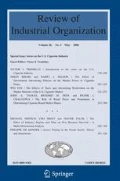Abstract
Firms compete with each other in numerous ways, but particularly interesting are the various ways in which they respond to competitive threats to their critical assets and operations. Firms may mount vigorous defenses, or they may launch offensive strategies—by some definitions perhaps even predatory—or they may do nothing at all. This paper takes a selective empirical approach to analyzing such actions. We examine one industry—airlines—and two carriers—United and US Airways—and analyze their price and capacity strategies when confronted by entry on specific routes or by certain rivals. This approach limits exogenous variation while offering insights into the determinants of incumbents’ strategies, such as the identity of the entrant, the likely prospects for driving it out, the nature of airport or route competition, and so forth.
Similar content being viewed by others
Notes
This, of course, does not imply that such markets are “contestable” since ground infrastructure, marketing, and network connectivity all limit the free flow of airborne capital from route to route.
See Kwoka et al. (2016) for evidence with regard to competition between flights at adjacent airports.
Here we follow Goolsbee and Syverson’s approach.
Virgin did, however, serve JFK airport in the New York area, with service to San Francisco, Los Angeles, Fort Lauderdale, Palm Springs, and Las Vegas. There is little doubt, however, that adjacent airports are generally distinct for most travelers.
We combine data for Continental Airlines and United, whose merger was announced in 2010.
Analysis of passenger data indicates that the price reduction was not due simply to demand shift.
Since these estimates are relative to the entry period, their statistical significance can be read directly.
A similar scenario of punishment for entry was part of the Justice Department case against American Airlines for predatory pricing against low-cost entrants at American’s Dallas–Fort Worth hub in 1999. See Edlin and Farrell (2004).
Similar muted competition among legacies has been found in Kwoka et al. (2016).
This disparity of entry dates precludes combining these events into the same regression model.
References
Aghion, P., & Bolton, P. (1987). Contracts as a barrier to entry. The American Economic Review, 77(3), 388–401.
Aguirregabiria, V., & Ho, C. Y. (2010). A dynamic game of airline network competition: Hub-and-spoke networks and entry deterrence. International Journal of Industrial Organization, 28(4), 377–382.
Bain, J. (1954). Economies of scale, concentration, and the condition of entry in twenty manufacturing industries. American Economic Review, 44(1), 15–39.
Cairns, R., & Galbraith, J. (1990). Artificial compatibility, barriers to entry, and frequent-flyer programs. Canadian Journal of Economics, 23(4), 807–816.
Conlin, M., & Kadiyali, V. (2006). Entry-deterring capacity in the Texas lodging industry. Journal of Economics & Management Strategy, 15(1), 167–185.
Cookson, J. A. (2018). Anticipated entry and entry deterrence: Evidence from the American casino. Industry Management Science, 64(5), 1975–2471.
Dafny, L. S. (2005). Games hospitals play: Entry deterrence in hospital procedure markets. Journal of Economics and Management Strategy, 14(3), 1975–2471.
Daraban, B., & Fournier, G. (2008). Incumbent responses to low-cost airline entry and exit: A spatial autoregressive panel data analysis. Research in Transportation Economics, 24(1), 15–24.
Dixit, A. (1980). The role of investment in entry-deterrence. The Economic Journal, 90(357), 95–106.
Edlin, A. S., & Farrell, J. (2004). The American airlines case: A chance to clarify predation policy. In J. Kwoka & L. J. White (Eds.), The antitrust revolution: Economics, competition, and policy (4th ed., pp. 502–527). Oxford: Oxford University Press.
Ellison, G., & Ellison, S. F. (2011). Strategic entry deterrence and the behavior of pharmaceutical incumbents prior to patent expiration. American Economic Journal: Microeconomics, 3(1), 1–36.
Gayle, P. G., & Wu, C. Y. (2013). A re-examination of incumbents’ response to the threat of entry: Evidence from the airline industry. Economics of Transportation, 2(4), 119–130.
Ghemawat, P. (1984). Capacity expansion in the titanium dioxide industry. The Journal of Industrial Economics, 33(2), 145–163.
Goolsbee, A., & Syverson, C. (2008). How do incumbents respond to the threat of entry? Evidence from the major airlines. The Quarterly Journal of Economics, 123(4), 1611–1633.
Kim, S. H. (2009). Predatory reputation in US airline markets. International Journal of Industrial Organization, 27(5), 592–604.
Klemperer, P. (1987). The competitiveness of markets with switching costs. RAND Journal of Economics, 18(1), 138–150.
Koscianski, J., & Mathis, S. (1996). Barriers to entry in the U.S. and Japanese titanium industries. International Advances in Economic Research, 2(3), 244–254.
Kwoka, J., Hearle, K., & Alepin, P. (2016). From the fringe to the forefront: Low cost carriers and airline price determination. Review of Industrial Organization, 48(3), 247–268.
Lieberman, M. (1987). Excess capacity as a barrier to entry: An empirical appraisal. Journal of Industrial Economics, 35(4), 607–627.
Seamans, R. (2012). Fighting city hall: Entry deterrence and technology upgrades in cable TV markets. Management Science, 58(3), 461–475.
Smiley, R. (1988). Empirical evidence on strategic entry deterrence. International Journal of Industrial Organization, 6(2), 167–180.
Spence, M. (1977). Entry, capacity, investment and oligopolistic pricing. The Bell Journal of Economics, 8(2), 534–544.
Stackelberg, H. V. (1934). Marktform and Gleichgewicht. Berlin: Springer.
Sylos-Labini, P. (1957). Oligopoly theory and technical progress. Cambridge: Harvard University Press.
Tan, K. M. (2016). Incumbent response to entry by low-cost carriers in the U.S. airline industry. Southern Economic Journal, 82(3), 874–892.
Tirole, J. (1988). The theory of industrial organization. Cambridge: MIT Press.
Author information
Authors and Affiliations
Corresponding author
Additional information
Comments from seminar participants at the International Industrial Organization Conference and the EARIE meetings are gratefully acknowledged. Remaining errors are the sole responsibility of the authors.
Rights and permissions
About this article
Cite this article
Kwoka, J., Batkeyev, B. Strategic Responses to Competitive Threats: Airlines in Action. Rev Ind Organ 54, 83–109 (2019). https://doi.org/10.1007/s11151-018-9664-6
Published:
Issue Date:
DOI: https://doi.org/10.1007/s11151-018-9664-6




